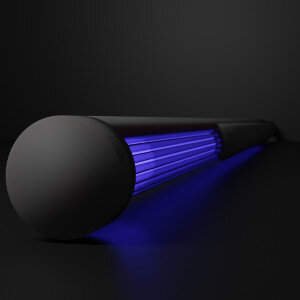
The goal of our project was to design a reactor that could degrade pharmaceuticals from urine. Urine has the potential to be a sustainable fertilizer with high nitrogen and moderate phosphorous concentrations with a 6 – 1 – 2 NPK value. However, undegraded pharmaceutical drug concentrations can slowly compound in produce being fertilized with the urine. As individuals consume these crops, the pharmaceutical drugs can be absorbed into their bodies. Studies on pharmaceutical removal from urine are currently being done, as well as the feasibility of urine as a fertilizer from a social, economic, and environmental viewpoint. Additionally, removing urine from municipal wastewater prevents the nutrients from harming local bodies of water due to eutrophication, which is when an algae bloom forms, leading to oxygen depletion.
Our process team, using John Goetze’s initial research, designed a UV photocatalytic reactor that degrades pharmaceutical contaminants within urine waste streams to concentrations below the limit of quantification, or the amount that can be detected with the appropriate equipment. Our team decided to use TiO2, titanium dioxide, as the photocatalyst because it is inexpensive and operates with self-sustaining reactions. The investigations relied on COMSOL to generate simple models that illustrate the reaction kinetics and fluid flow patterns inside each potential reactor design. The design involved a 360° serpentine pattern around the UV light that allowed for both increased residence time and UV light contact time for the waste fluid inside the reactor. The results indicated that the processed urine concentration decreases to below the LOQ value in 60 minutes. The process team created a cost-efficient product that could be used inside consumer’s homes using 3D printed technology.
Other applications could be for Martian settlements and developing communities. Rather than bringing fertilizer with you to space or needing to purchase it for your community, the reactor can produce enough fertilizer to sustain multiple gardens year-round. Our reactor can easily be maintained with 3D printed parts and other affordable components. The costs associated with the reactor production are a $415 capital cost with a $94 annual operating cost.
